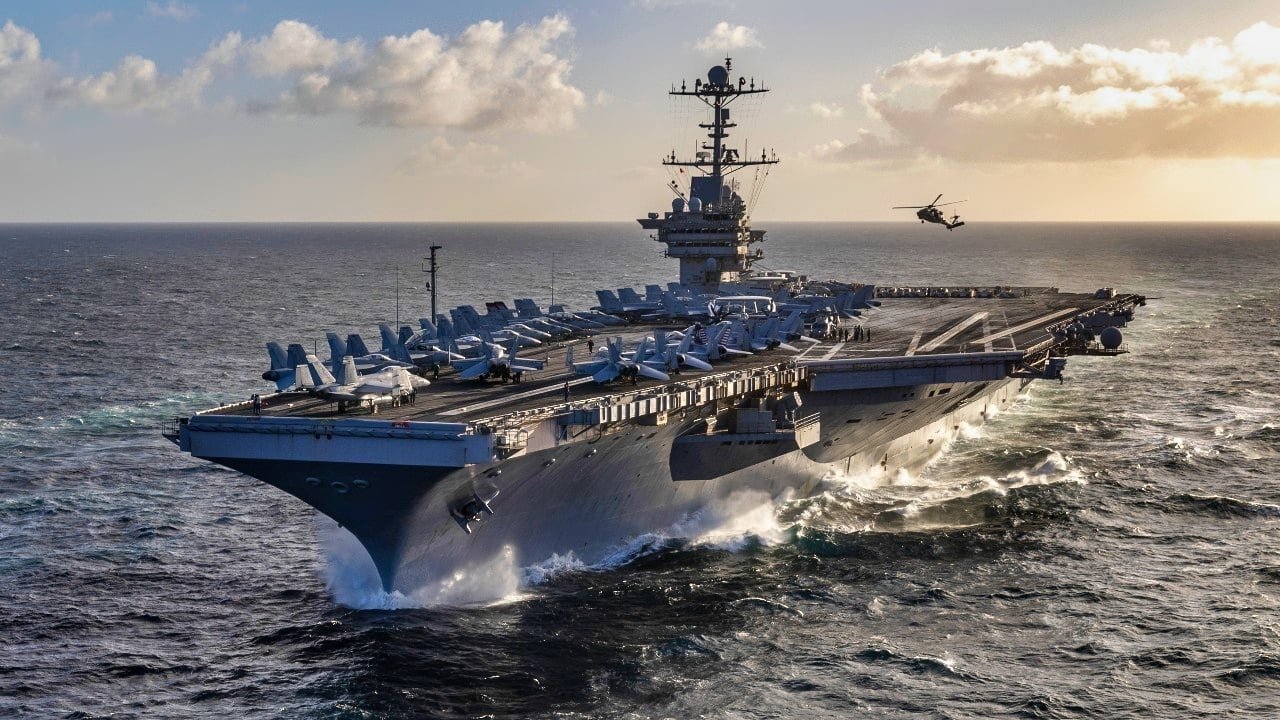What You Need to Know: The USS Harry S. Truman, a Nimitz-class nuclear-powered aircraft carrier, has deployed to the Arctic Circle for joint training with Norway’s Royal Norwegian Air Force (RNoAF), marking a strategic shift from its expected Middle East mission.

-This deployment emphasizes NATO’s commitment to Arctic security amid heightened tensions with Russia, which views the region as its domain. The carrier’s presence in the Arctic signals collective defense efforts, particularly for North Atlantic security.
-While the Truman’s deployment highlights the U.S. Navy’s stretched resources, it could still pivot to the Middle East as planned following Arctic exercises.
USS Harry S. Truman is on Russia’s Doorsteps
When the Nimitz-class nuclear-powered aircraft carrier USS Harry S. Truman (CVN-75) departed Naval Station Norfolk on September 23, the crew likely expected they’d need to pull out the sunblock as it appeared the warship and its strike group would be headed to the Middle East, likely operating from the eastern Mediterranean or Red Sea. The United States Navy has maintained a near-constant presence in the region since October 2023 when Israel responded to the Hamas terrorist attack by invading Gaza.
Washington has sought to deter Iran and its regional proxies, and has rotated several nuclear-powered carriers to the region – but for now, CVN-75 won’t be headed there. Instead, the crew may need a warm pullover and even a heavy winter coat, as the USS Harry S. Truman is now operating in the Arctic Circle.
“It is a powerful force we now get to practice with, which also demonstrates our allies’ ability and willingness to defend Norwegian areas of interest in the north,” Colonel Ole Marius Tørrisplass told The Barents Observer.

Tørrisplass, chief of the 132nd Air Wing, the unit that operates Norway’s fleet of F-35 fighter jets at Ørland Air Station, welcomed the U.S. Navy’s eighth Nimitz-class aircraft carrier, as it will now take part in training exercises with the Royal Norwegian Air Force (RNoAF). Oslo received two F-35 Lockheed Martin F-35 Lightning IIs just last week, and now operates 40 of the fifth-generation multirole stealth fighters – with plans to acquire a total of 52. Those aircraft will train alongside the 65 aircraft on the carrier.
“This is a unique opportunity to train with our most important ally. This is a force larger than the entire Norwegian Air Force,” Tørrisplass explained.
The arrival of CVN-75 is the first NATO carrier to the Arctic region since the Royal Navy’s Queen Elizabeth-class carrier took part in this year’s Nordic Response exercises, while it was last year that USS Gerald R. Ford (CVN-78) operated alongside RNoAF aircraft during the Arctic Challenge Exercise. During the biannual Nordic drills, aircraft from Sweden and Finland – which respectively joined the international alliance following Russia’s unprovoked invasion of Ukraine in February 2022 – also took part.
Last month, USS Harry S. Truman transited the Straits of Dover and took part in operations with NATO partners in the North Sea. It was the first time the flattop named for the 33rd president had operated in the region since 2018.
NATO’s Arctic Strategy
Norway is one of several nations that is now increasingly focused on the Arctic, which could be the epicenter of a Cold War 2.0, as Russia increasingly sees the region as solely its to control. The arrival of USS Harry S. Truman is clearly meant to send a message to the Kremlin that it will face competition for the resources in the region.

It is just the third time since the end of the Cold War that the U.S. Navy has deployed a nuclear-powered carrier to the frigid waters – but it puts into question exactly what Washington and even NATO hope to accomplish.
“NATO might not have an Arctic Strategy, but the repeat appearance of a U.S. aircraft carrier taking part in training exercise above the Arctic Circle certainly points to a deepened commitment to North Atlantic security for the alliance,” Elizabeth Buchanan, a polar geopolitics expert at Australian Strategic Policy Institute, told GCaption.com.
“The presence is an important signal for the close bilateral relationship and increases the credibility of collective defense and deterrence,” added Vice Admiral Rune Andersen, Chief of the Norwegian Joint Headquarters (NJHQ). “The visit shows that NATO is ready to defend itself, and that we stand together in this. The current security situation will not pass quickly, so we must get used to higher military activity almost continuously.”
What About the Middle East?
USS Harry S. Truman was last deployed to the Eastern Mediterranean in early December 2021 as part of the Department of Defense’s (DoD’s) response to the then-anticipated Russian invasion of Ukraine. CVN-75 remained in the region until September 2022, spending 285 days deployed.
CVN-75 was originally slated to replace USS Theodore Roosevelt (CVN-71) in the Middle East to allow the U.S. to maintain two carriers in the region.
It was announced earlier this month that USS Abraham Lincoln (CVN-72), which was deployed to the Middle East in August, will end the U.S. Navy’s carrier presence in the coming weeks. Instead, the Pentagon has rotated B-52 bombers and other aircraft while the amphibious assault ship USS Wasp (LHD-1), her amphibious ready group, and the 24th Marine Expeditionary Unit remained positioned in the Eastern Mediterranean.
It is possible, and perhaps even likely that following the exercises in the Arctic Circle, USS Harry S. Truman will deploy the Middle East – but this is yet another reminder of how stretched thin the U.S. Navy’s flattops are right now!
Author Experience and Expertise: Peter Suciu
Peter Suciu is a Michigan-based writer. He has contributed to more than four dozen magazines, newspapers, and websites with over 3,200 published pieces over a twenty-year career in journalism. He regularly writes about military hardware, firearms history, cybersecurity, politics, and international affairs. Peter is also a Contributing Writer for Forbes and Clearance Jobs. You can follow him on Twitter: @PeterSuciu. You can email the author: [email protected].
Image Credit: Creative Commons and/or Shutterstock.
From the Vault
